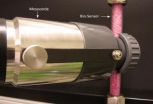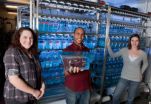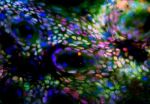(Press-News.org) New research at Rice University could ultimately show scientists the way to make batches of nanotubes of a single type.
A paper in the online journal Physical Review Letters unveils an elegant formula by Rice University physicist Boris Yakobson and his colleagues that defines the energy of a piece of graphene cut at any angle.
Yakobson, a professor in mechanical engineering and materials science and of chemistry, said this alone is significant because the way graphene handles energy depends upon the angle -- or chirality -- of its edge, and solving that process for odd angles has been extremely challenging. But, he wrote, the research has "profound implications in the context of nanotube growth, offering rational ways to control their chiral symmetry, a tantalizing yet so far elusive goal."
Graphene is the single-atom-thick form of carbon that has become of tremendous interest for its potential to revolutionize electronics, optics, sensing and mechanical devices. Getting a handle on how this chicken-wire-shaped sheet of carbon atoms transports electricity has been the focus of intense study.
A sheet of graphene with zigzag or armchair edges squares up nicely. Zigzags are metallic, armchairs are semiconductors, and their atoms march in rank, evenly spaced, along the edges. A full 30 degrees of rotation separates one from the other.
But if the hexagons that make up a sheet are offset less than 30 degrees, atoms along a straight edge are unevenly spaced. "That makes analysis of the energy very complicated, because it's a large irregular structure. It's like noise," Yakobson said. "We've found a way to calculate the energies in these arbitrary angles," he said.
Yakobson and his co-authors, Yuanyue Liu, a graduate student in his lab, and Alex Dobrinsky, a former graduate student and now a postdoctoral researcher at Brown University, soon wondered how these findings applied to carbon nanotubes.
"There are as many ways to roll graphene into a nanotube as there are ways to roll a newspaper," Yakobson said. "The text can be aligned circumferentially or run straight along the axis or spiral at an angle."
While rolling a newspaper makes it hard to read, rolling carbon into a nanotube makes it relatively easy to "read" its type -- whether armchair or zigzag or some variation in between. What's impossible is controlling how the tube will roll. The process tends to be willy-nilly, leaving researchers the task of separating the nanotubes they need from the bulk through ultracentrifugation or other expensive procedures.
Yakobson said it would be a real game-changer if they could, for instance, grow batches of pure armchair nanotubes for use in such projects as armchair quantum nanowire (AQW). As imagined by Rice's late Nobel Laureate Richard Smalley, AQW could revolutionize the nation's power grid by carrying 10 times the amount of electricity as copper at only one-sixth the weight.
Yakobson's work may open a path to do so. A nanotube's chirality is determined by the combination of energies at play in its nucleation. "When it just emerges from the 'primordial soup' of carbon, the edge of the tube is essentially the same as the edge of graphene," he said.
"At first, it's just a cap. There's no stem yet. You're frying these caps on a skillet, and they're bubbling," he said. "The probability for different bubbles to emerge is controlled by energy around the edge."
The chirality of the nascent nanotube is set when atoms in the cap self-assemble a sixth pentagon (necessary to mold the hexagons into a dome). "That's where we can, I think for the first time, make some quantitative judgment about how different chiral structures emerge," Yakobson said.
It may be worth chemists' efforts to look more closely at the energy between the catalyst and carbon structure. "This has some promise," he said. "If you can tweak this preference, if you can change energy from the catalyst side, you change the preference of the chirality. And then you can tell these self-assembling carbons, 'Please dance this way; don't dance that way.'"
Yakobson hopes the new work helps solve the long-standing problem of nanotube chirality. "For almost two decades, we didn't have a good understanding of this process," he said. "Actually, we didn't have a clue. I'm not saying this is a full solution, but this is the first time we've seen a quantitative approach, an order in the seeming chaos. It just feels satisfying.
"The bottom line is simple. We figured out the graphene edge and bridged it to the holy grail of nanotubes, which is chirality control."
###
Read the abstract at: http://prl.aps.org/abstract/PRL/v105/i23/e235502
Located in Houston, Rice University is consistently ranked one of America's best teaching and research universities. Known for its "unconventional wisdom," Rice is distinguished by its: size -- 3,279 undergraduates and 2,277 graduate students; selectivity -- 12 applicants for each place in the freshman class; resources -- an undergraduate student-to-faculty ratio of 5-to-1; sixth largest endowment per student among American private research universities; residential college system, which builds communities that are both close-knit and diverse; and collaborative culture, which crosses disciplines, integrates teaching and research, and intermingles undergraduate and graduate work.
END
Investigators report no evidence of toxicity in the four hemophilia B patients enrolled to date in a gene therapy trial using a vector under development at St. Jude Children's Research Hospital and UCL (University College London) to correct the inherited bleeding disorder.
This trial was designed primarily as a safety test, with low and intermediate doses of the vector expected to produce little detectable Factor IX. The Factor IX protein helps the blood form clots. Individual with hemophilia B lack adequate levels of this clotting factor. The first participant in the ...
People with psychotic disorders, such as schizophrenia or bipolar disorder, are 12 times more likely to commit suicide than average, according to research released today by King's Health Partners.
The research found that the rate of suicide was highest in the first year following diagnosis (12 times national average) and that high risk persisted – remaining four times greater than the general population ten years after diagnosis, a time when there may be less intense clinical monitoring of risk.
Neither the risk of suicide nor the long-term risk of suicide, as compared ...
CORVALLIS, Ore. – It's illegal for businesses and law enforcement to profile a person based on their race, gender, or ethnicity, yet millions of Americans are being profiled every day based on their online consumer behavior and demographics.
Known as consumer profiling for behavioral advertising purposes, this type of profiling is largely unregulated.
The result, according to two recent articles in the journal of Computer Law & Security Review, is that consumers have less privacy and are being targeted by advertisers using increasingly sophisticated measures, which ...
It is supposed to be cool, colorless, tasteless and odorless. It may not have any pathogens or impair your health. This is the reason why drinking water is put to a whole series of screenings at regular intervals. Now, the AquaBioTox project will be added to create a system for constant real-time drinking water monitoring. At present, the tests required by the German Drinking Water Ordinance are limited to random samples that often only provide findings after hours and are always attuned to specific substances. In contrast, the heart of the AquaBioTox system is a bio-sensor ...
A gene that can cause congenital heart defects has been identified by a team of scientists, including a group from Princeton University. The discovery could lead to new treatments for those affected by the conditions brought on by the birth defect.
Princeton researchers focused on identifying and studying the gene in zebrafish embryos, and the team's work expanded to include collaborations with other groups studying the genetics of mice and people.
"This work really showcases the use of collaborative science and multiple model systems to better understand human disease," ...
AUGUSTA, Ga. – A drug prescribed for Parkinson's disease may also treat restless leg syndrome without the adverse side effects of current therapies, Medical College of Georgia researchers say.
Rasagaline works by prolonging the effect of dopamine, a chemical that transmits signals between nerve cells in the brain. The cause of RLS is unknown, but research suggests a dopamine imbalance. Parkinson's is caused by a dopamine insufficiency.
"The hope is that Rasagaline, because it prolongs the effect of existing dopamine, instead of producing more, will not come with adverse ...
ROCHESTER, Minn. -- Mayo Clinic researchers studied more than 200 children with epilepsy and found that even if the cause of focal-onset seizures cannot be identified and they do not fit into a known epilepsy syndrome, long-term prognosis is still excellent. This study was presented at the American Epilepsy Society's (http://www.aesnet.org/) annual meeting in San Antonio on Dec. 4.
Epilepsy (http://www.mayoclinic.org/epilepsy/) is a disorder characterized by the occurrence of two or more seizures. It affects almost 3 million Americans, and approximately 45,000 children ...
Cleveland - Scientists from South Korea, the United States and Japan analyzed fossil evidence found in South Korea and published research describing a new horned dinosaur. The newly identified genus, Koreaceratops hwaseongensis, lived about 103 million years ago during the late Early Cretaceous period. The specimen is the first ceratopsian dinosaur from the Korean peninsula. The partial skeleton includes a significant portion of the animal's backbone, hip bone, partial hind limbs and a nearly complete tail. Results from the analysis of the specimen were published in ...
PHILADELPHIA - In a study published in the journal Developmental Cell, Sarah Millar PhD, professor of Dermatology and Cell & Developmental Biology at the University of Pennsylvania School of Medicine, and colleagues demonstrate that a pair of enzymes called HDACs are critical to the proper formation of mammalian skin.
The findings, Millar says, not only provide information about the molecular processes underlying skin development, they also suggest a potential anticancer strategy. "Inhibition of these HDAC enzymes might be able to shut down the growth of tumors that ...
Only the fragile chicken egg stands between Americans and a flu pandemic that would claim tens of thousands more lives than are usually lost to the flu each year.
Vaccine production hinges on the availability of hundreds of millions of eggs – and even with the vaccine, flu still claims somewhere around 36,000 lives in the United States during a typical year. Now scientists have taken an important step toward ending the dominance of the oval. In a paper published in the Dec. 6 issue of the journal Vaccine, scientists showed that an experimental flu vaccine grown entirely ...



